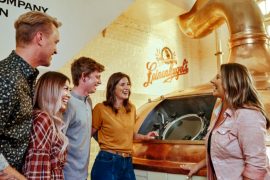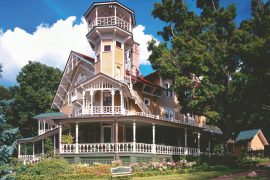Photo © Bill Frantz
Once upon a time, nearly a half-century ago, Lake Geneva was quietly hand-picked by Playboy Enterprises to be the site of a glamorous new resort. It would be like nothing the area had ever seen, with picturesque grounds, progressive architecture and nationally-recognized music and entertainment. Taken together, the Playboy Club-Hotel represented the epitome of the era’s decadence and sophistication, a resort where those in the know could ski, horseback ride, golf, dine and be up-close and almost personal to the world’s top performers.
BUNNY COUNTRY
In August 1966, Playboy founder and president Hugh Hefner arrived at the site of the future Playboy Club-Hotel in Lake Geneva by helicopter for the grand groundbreaking of the new resort. Wearing a hardhat featuring the Playboy logo and surrounded by a bevy of Bunnies in evening gowns, Hefner set off a dynamite charge to signal the official groundbreaking. Local dignitaries enjoyed a gala celebration under a tent while skydivers dropped onto the property, one of whom carried an Olympic-style torch and a Playboy flag to plant in the ground. Playboy had arrived in Lake Geneva as only Playboy could.
Construction on the seven interconnected buildings that would make up the resort took a little over a year. The Lake Geneva Playboy Club-Hotel opened in May 1968, and included the Main Lodge, two golf courses, a ski chalet, a fitness and racquet center, and housing for employees dubbed the “Bunny Dorm.”
The Main Lodge contained 350 guest rooms, ten meeting rooms, three bar/restaurants (including one that could be converted to a nightclub theater), a dance club, a barbershop/salon and several shops. According to his daughter Christie, the Lake Geneva resort was one of Hefner’s favorite Playboy properties: “Hef loved the Lake Geneva resort both because it was one of the company’s first resorts and because it was so beautifully designed.”
From the day it opened, the Lake Geneva Playboy Club-Hotel was immediately popular with tourists and locals alike. The success of the venture depended partly on the top-of-the-line resort offerings and partly on the gimmick of the costumed Playboy Bunnies themselves. Competition for a Bunny position was fierce, and women selected for the job underwent rigorous training in proper cocktail garnishing, physical presentation and serving technique, among other skills. A Bunny Mother constantly monitored their behavior and appearance, and could issue a disciplinary note for various infractions, including if a Bunny gained five pounds; failure to lose the added weight could result in a temporary layoff. They were trained to be extremely attentive to customers, but to maintain a decorous distance at all times, all while wearing a corseted bodysuit and a pair of three-inch heels. The Playboy Bunnies, and by extension the Playboy Club-Hotel, represented everything that was new and exciting about modern culture in the wake of the sexual revolution.
A LITTLE BIT ROCK AND ROLL
The resort’s popularity attracted celebrities, athletes and wealthy guests, and Playboy Enterprises had recently expanded into the music and television industry. Hoping to capitalize on all of these connections, local entrepreneur Andy Waterman negotiated a deal with Playboy to construct a world-class recording studio on the property and lease it to him. Expanding on the business started by local jingle-writers Vern and Jan Castle, where Waterman had previously worked, he renamed the studio Shade Tree Records. It opened in 1978.
Despite attracting big-name talent like John Mellencamp, Cheap Trick, Guns ‘N Roses and Red Hot Chili Peppers, Waterman struggled to make a profit. Finally, facing pressure from an increasingly digitized music industry, the recording studio shuttered its doors for good in 1995, selling off its state-of-the-art recording console, which is now rumored to reside in the private Chicago studio of R&B star R. Kelly.
THE AMERICANA ERA
In 1981, citing changing tastes and poor financial performance, Playboy closed all of its resorts to refocus the company’s efforts on its primary market: media. They sold the Lake Geneva resort and property to Chicago-based hospitality group Americana Hotels Corp., for just under $12 million.
The new management changed the name to Americana and attempted to rebrand the resort as a family-friendly country getaway. The once envelope-pushing Living Room Restaurant became Annie’s Country Kitchen. The early years of Americana’s stewardship saw successful occupancy rates and increased conference business, while retaining the celebrity cache that Playboy had cultivated; John Denver, Mickey Mantle, OJ Simpson and countless Chicago baseball players all visited the newly branded resort.
But after a few short years, the buildings needed repairs and updates. The ski hill and the golf courses continued to attract big business, but the resort itself couldn’t compete with other nearby options. By 1986, Americana entered foreclosure. In 1988, Americana Hotels Corp. sold the resort to another Chicago-based real estate group, JMB Realty Corp., but they couldn’t save the declining resort either. They opened Americana only in the summer and closed off many of the rooms.
In 1992, JMB Realty Corp. folded and Americana went up for sale at auction. No buyers met the minimum bid.
MARCUS TO THE RESCUE
In 1993, executives from Milwaukee’s Marcus Corporation came to Lake Geneva to inspect the property. Marcus had a reputation for rescuing run-down hotel properties; decades earlier, the company had saved Milwaukee’s historic Pfister Hotel from the wrecking ball and restored it to its former glory as one of the most luxurious hotels in the city. Despite the significant amount of renovation the former Playboy Club needed at the time, the Marcus team saw potential in the property. “This is one of the prettiest 1,300 acres of property in the state of Wisconsin,” former Marcus Hotel Division President Lee Berthelsen said.
Over the next decade, Marcus increased the meeting space and added a ballroom for events, redesigned the two golf courses, added a full-service spa, upgraded the ski hill and expanded the ski school, created six outdoor tennis courts, renovated the fitness center and upgraded the equipment and further expanded the meeting and conference facilities. In addition, they added three successful restaurants: Ristorante Brissago, the Geneva ChopHouse, and the Grand Café, plus new recreation in the form of the Timber Ridge Lodge & Waterpark, a 50,000-square-foot, indoor/outdoor waterpark, and reintroduced horseback riding to the property. Today, Grand Geneva has earned countless awards, including a coveted AAA Four-Diamond rating for 16 consecutive years, one of the most prestigious trademarks in the global travel industry.
This article originally appeared in the 2016 fall/winter issue of Experience Wisconsin magazine. The contents of this article were checked for accuracy when it was published; however, it’s possible some of the information has changed. We recommend you call first if you have specific questions for the destinations, attractions or restaurants mentioned in this article.
No portion of this article or magazine may be reproduced without prior written permission by the publisher.






5 Comments
Pingback: Frosty Fun at Lake Geneva's Winterfest - Experience Wisconsin
Pingback: Artful Escapes at Milwaukee’s Iconic Pfister Hotel | Experience Wisconsin
Pingback: An Artful Abode in Milwaukee | Experience Wisconsin
Pingback: 6 Festive Holiday Celebrations Throughout Wisconsin | Experience Wisconsin
Pingback: Try These Winter Date Night Ideas in Lake Geneva | Experience Wisconsin